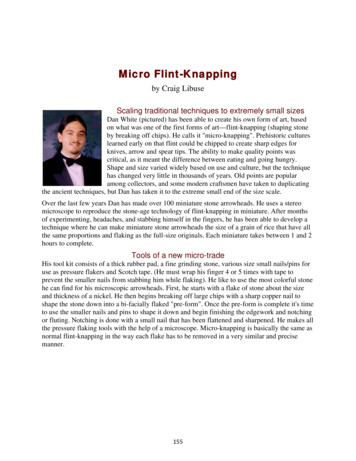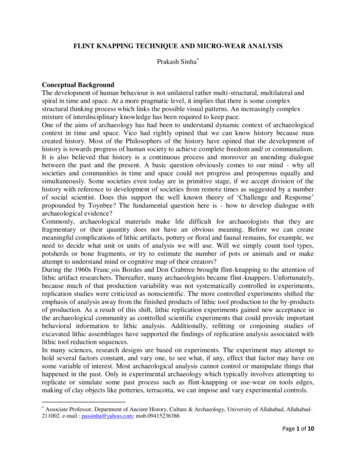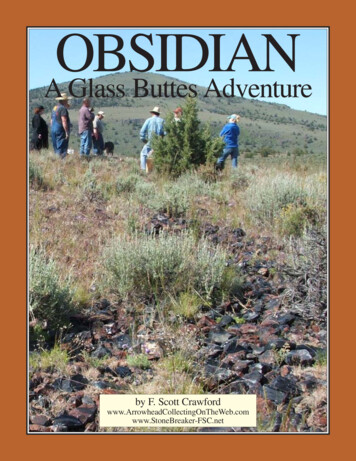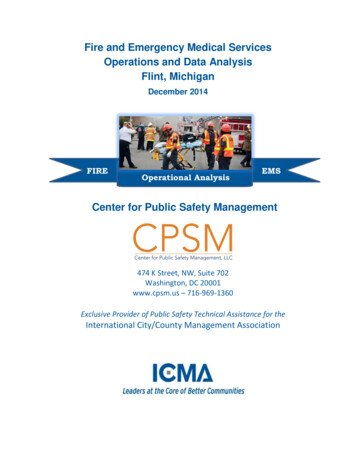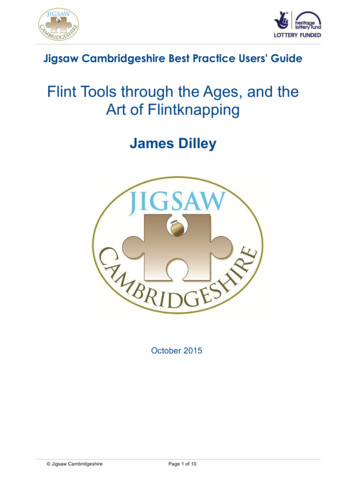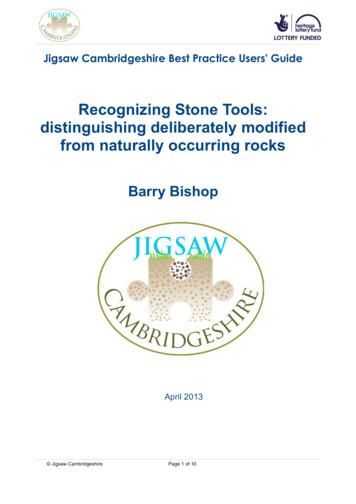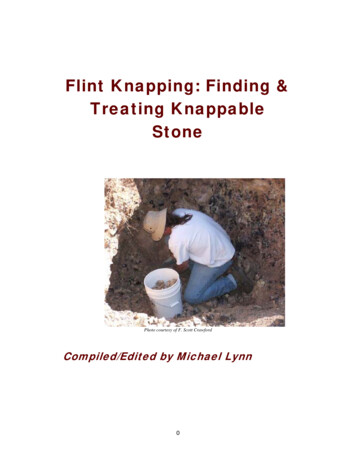
Transcription
Flint Knapping: Finding &Treating KnappableStonePhoto courtesy of F. Scott CrawfordCompiled/Edited by Michael Lynn0
Photo of Tim Dillard teaching me at theCenter for American Archaeology in Kampsville, ILDedicated to all those who have taught someone else aboutthe art of flint knapping, especially to my primary teachers– Bruce Boda, Tim Dillard, Mike McGrath and Steve Nissly.This is my attempt to pay forward. Michael Lynn, 2010Although the copyrights to the individual articles and tutorials in this e-bookbelong to the authors, I have copyrighted this collection. It may be freely printed,copied, posted on the internet and otherwise distributed as long as saiddistribution is free and appropriate credit is given to me and the authors. This ebook may not be sold for profit.1
Flint Knapping: Finding & TreatingKnappable StoneWhere Can I Find Flint?by Mark Bracken at www.flintknapping tools.com3Rockhounding Lawby Gregory Tolbert at www.gatorgirlrocks.com4Flintknapping Buyers Tipsby Wilkie Collins at www.nativewayonline.com10Heat Treatmentby Travis Smolinski at www.sparrow creek.com18Heat Treating Tips and Temperaturesby Mark Bracken at www.flintknapping tools.com23Heat Treating Time/Temperature Tableby Richard Urata262
Where Can I find Flint?by Mark BrackenHunting flint is one of my favorite things to do. It's an adventure every time I go on arock hunt! Over the years I have searched far and wide for the finest and most colorfulmaterials for knapping. Many times I have come up empty handed and an empty gastank. I always wondered where the "Mother Lode" was or if such a thing existed. In myquest, over the years, I have found some fantastic flint sources. It is a lot of hard work yetvery satisfying experience.Here are some tips for your next rock hunt!The best advise I can give to the "flint hunter" is this: familiarize yourself with geologicalmaps of the areas you plan to hunt. Look everywhere, in plowed fields, look in the gravelof creek and river bottoms, construction sites, under bridges and eroded roadside ditches.Be sure to get permission from land owners first! I assure you it is not worth the risk. Therewards are greater when material is gathered with a blessing from the land owner.Beware of "freeze fractured" flint. This is flint that has been exposed to freezing andliterally frozen. The problem starts with this. Flint and all other stones contain moisturedeep within the stone, when the temperature falls well below 32 f. the result of theexpanding freezing moisture is fractures the flint. This is a bad thing for knappers. Thismaterial is useless unless the pieces are large enough to knap. You want pure crack freestone. It can be a serious challenge to find high grade stone. If you plan on gettingmaterial from construction sites, get them before it freezes. These stones have never beenexposed to freezing temperatures and when they do, they will likely suffer. Searchingcreek and river bottoms can be a lot of fun. Take a big copper billet and start testing thegravel to see what is inside. You never know what you might find!In summary, do a lot of research. Talk to artifact hunters, they know what the flints looklike from their area. Don't waist your time in areas where there is no flint to be found.Don't expect other knappers to reveal their sources. Many a knapper has spent years tofind their "honey holes". Remember, always get the land owners permission to hunt rockson their property! Try to hunt areas that have not been exposed to freezing. Use commonsense, have safety equipment along. Take Band-Aids, gloves, safety glasses and longpants. Just take a day off work and get a tank full of gas and have fun exploring thecountry side. It's great fun! you never know what you might find!If you don't have much luck or just don't have the time you can get good material fromreputable rock dealers. You want to learn more about modern knapping? Simply searchthis site or view the Links page.From http://www.flintknappingtools.com/where flint.html, March 31, 2010, copied withpermission3
Rockhounding Lawby Gregory TolbertLegal Mumbo Jumbo & DisclaimerWe live in a country with too many lawyers and too many judges andjuries who seem to be intent on eliminating the last tattered shreds ofcommon sense. Accordingly, we begin by stating what should be obviousto everyone.This Guide is free. You didn't pay a penny for it. And, although it is anawesome piece of work, it is a general overview. There will be errors,omissions, and even silly mistakes. In fact, there may be quite a few.Nonetheless, the authors disclaim any and all liability of any and everykind, express, implied, or otherwise. Simply stated, we're volunteering toassemble these materials so that you might have an opportunity to havesome fun, maybe learn something, and spend some time experiencingthe inherent magic that results from an outdoors adventure with a child.We're not signing up for a lawsuit resulting from misplaced reliance orany other legal theory grounded ultimately in a lack of personalresponsibility.We are not your lawyer and (obviously) you are not hiring or relying on usfor any legal counsel. If you need a lawyer, you need to hire a lawyer.Be responsible. Be prepared. Plan ahead. Know your limits. Otherwise,stay home. 4
R OCKHOUNDING LAW GUIDEFEDERAL LAW SUMMARYSurprisingly ‐ especially given the number of lawyers in the United States ‐ there is not asuccinct, simple, helpful, practical summary of the law pertaining to collecting rocks,minerals, gems, fossils, and artifacts.Following a brief introduction, this Guide is provides a summary chart of federalrockhounding law. Because the chart is simply a summary, it does not cover everysituation or every detail. Rather, the chart is intended to provide an overview.INTRODUCTIONThe law pertaining to rockhounding (i.e., collecting rocks, gemstones, minerals, fossils,meteorites, and artifacts), is extremely complicated. Generally speaking, the applicablelaw depends upon four critical facts:(1)Ownership of the property where the collecting occurs;(2)The type of material — e.g., rocks (such as obsidian), gemstones (such as garnets,agates, etc.), minerals (such as gold, silver, copper, etc.), petrified wood, fossils(plant, invertebrate, vertebrate, and trace), meteorites, etc.;(3)The manner of collecting—e.g., surface collection, hand tools, digging,mechanized, blasting; and(4)What type of person you happen to be. Seriously, that matters.5
PROPERTY OWNERSHIPThe property ownership question is pretty easy. In America, all real property belongs tosomeone (and, increasingly, more than one person). Generally speaking, there are twocategories: Private Property and Public Property. Some may quibble that certainproperty ownership has elements of both (e.g., tribal trust lands; taxpayer subsidizedprivate conservation easements, etc.), but, in regard to rockhounding, these twocategories will suffice.Rockhounding on private property is easy. If you own the property or have permissionto be there (e.g., fee access; permit; prescriptive use; etc.), you can engage inrockhounding.Rockhounding on public property is more complicated. Certainly, if you're not an idiot,you wouldn't expect that, just because the property is publicly owned, you could startrockhounding in the middle of the White House lawn or in a city park. On other hand, ifwealthy self‐proclaimed 'environmentalists' can lock up millions of acres of publicproperty essentially for an exclusive wilderness hiking experience for a ridiculously tinynumber of souls fortunate enough to have sufficient treasure and time to engage inextended wilderness 'experiences,' certainly there must be room in this country forordinary children and their families to experience the outdoors and collect some rocks.Good news. There is. There is not a lot of opportunity and most areas are prettyremote, but, there are places where it is not illegal to collect some rocks and somefossils on public land.Generally Speaking, in regard to federal property, certain public lands typically areclosed to rockhounding.THE TYPE OF MATERIALWhen it comes to the type of material to be collected, the law varies wildly and there isno uniform rule. For example, some federal lands prohibit all collecting ‐ rocks, gems,minerals, fossils, petrified wood, etc. On the other land, certain federal lands are opento rock collecting or to collecting a prescribed number of pounds of petrified wood, orcertain fossils depending on whether they are invertebrate or vertebrate fossils.Similarly, state and local law varies. Tribal lands also vary.6
THE MANER OF COLLECTINGThe manner of collection often is regulated. On private property, generally speaking,the method of collection is up to the property owner.On public property where rockhounding is permissible, there often are policiespertaining to collection methods. Commonly, only nonmechanized methods may beused (e.g., hand tools, picks, shovels) and, although common sense should dictate thisanyway, surface improvements (e.g., roads, buildings, etc.) and trees must not bedamaged and the surface must be restored.WHO YOU AREThe type of material or specimens that you may collect willdepend upon your status. If, for example, you are a scientist, you will be able to collectmore types of materials and specimens than if you are not (albeit not for a personalcollection or sale). Similarly, if your activities are being conducted pursuant to a permit,you again will have greater latitude.That said, if the property belongs to you, you have no legal obligation to provide accessto scientists to engage in recovery or collection on your private property.BEFORE YOU HEAD OUT Before you head out rockhounding, common sense would suggest that you be prepared,know where you are going, know what you plan to collect, and know for certain that theproperty is open to collecting. That said, common sense commonly isn’t always used.Accordingly, a few tips before you head out:7
Be prepared. Identify the property where you plan to collect and determine its currentownership and that the property is open to rockhounding. If a permission or a permit is required, get it. Know and understand any applicable limits on your activity – e.g., is there acollection limit? Understand and appreciate that commercial collecting is NOT recreationalrockhounding.Far too often we hear reports of‘rockhounders’ who are cited (oroccasionallymerelyscolded)forcollecting where they are not allowed or,if allowed, collecting without a permit orcollecting prohibited specimens. Suchillegal activity, sadly, tarnishes the goodreputation of the many decent folks whoare recreational rockhounders and whodo comply with the rules. Further, suchillegal activity encourages privatelandowners to prohibit all rockhoundingand provides great arguments for folkswho wish to reduce or eliminaterockhounding on public lands.In short, before you begin collecting, know where you are and investigate the applicablerules.8
UNDERSTANDING FEDERAL PUBLIC LANDSThe federal government owns an astonishing amount of real property. In fact, West ofthe 100th meridian, the federal government owns the majority of the real property. TheBLM and USFS manage nearly half a billion acres (over 450,000,000 acres).Some of this property is open to rockhounding subject to certain terms and conditions.Before heading out to rockhound on federal property, you should understand thedifferent categories of federal property and the rules relevant to such categories. Keepin mind, however, that certain properties may have additional restrictions.Generally speaking, whether rockhounding is permissible on federal property dependson three things: First, what type of public land (more precisely, the management regimepertaining to the public land). For example, rockhounding is prohibitedin national parks (e.g., Yellowstone National Park) but often is allowed innational forests. Second, what type of specimen ‐ e.g., rocks, gems, invertebrate fossils,vertebrate fossils, petrified wood, etc. Third, what type of rockhounding. This part, is very complicated. The rulesvary wildly depending upon the type of rockhounding at issue ‐ e.g., simplesurface rock collecting, digging, gold panning, mechanized rock collecting, etc.SIGNIFICANT MANAGEMENT AGENCIES FOR FEDERAL PUBLIC LANDSFederal property is managed by a variety of federal departments, agencies,and organizations. These include: Bureau of Land Management (BLM) Bureau of Reclamation (BOR) Department of Defense (DOD) Department of Energy (DOE) Fish and Wildlife Service (F&WS) Forest Service (USFS) National Park Service (NPS)9
Generally speaking, rockhounding by children and their families is permissibleon only a couple of categories of federal property. Even in these categories,however, there are site-specific prohibitions and restrictions, additional termsand conditions, and complicated rules and exceptions. Understanding thevarious categories of federal ownership, however, helps set the table tounderstand the rules.WHETHER ROCKHOUNDING IS ALLOWEDMAY BE ALLOWEDPROHIBITEDPortions of BLM‐managed publiclandsOffices – e.g., White House; federalagency buildings and campuses;GSA‐managed properties, etc.Portions of National Forests – e.g.,Flathead National ForestDepartment of Defense properties ‐e.g., Military bases; Firing andbombing ranges; cemeteries; etc.Portions of National Grasslands –e.g., Oglala National GrasslandDepartment of Energy properties ‐e.g., Alamogordo, Hanford NuclearReservation; Idaho facilitiesDepartment of Transportationproperties ‐ e.g., InterstatehighwaysBureau of Reclamation properties ‐e.g., Dams, resevoirsCorps of Engineers properties ‐ e.g.,Canals; etc.Correctional FacilitiesNational Parks ‐ e.g., YellowstoneNational ParkNational Monuments ‐ e.g., JohnDay Fossil BedsNational Wildlife Refuges ‐ e.g.,10
WHETHER ROCKHOUNDING IS ALLOWEDMAY BE ALLOWEDPROHIBITEDNisqually National Wildlife RefugeWilderness AreasIndian Sacred SitesHistoric Districts & Historic SitesNational Scenic Areas ‐ e.g.,Columbia Gorge National ScenicArea11
12
13
Note: Greg Tolbert is an attorney with considerable mineral resources and naturalresources legal experience. bert-19754.html). Greg is one of the very few attorneys in the United Stateswith both a law degree and an advanced legal degree in natural resources andenvironmental law (LL.M.) and is an honors graduate from college, law school,and his LL.M. everguides/federallawsummary.html,accessed 12-17-10, copied with permission14
Flintknapping Buyer's Tipsby Wilkie CollinsThese tips could save you hundreds of dollars1) Many people who sell knapping stone do not know how to grade it very well forflintknapping.Silica is available at about 3 cents per pound in the form of gravel and up to 1500 dollarsper pound in the form of semiprecious stones. Knappable silica is somewhere betweenthese two figures in value, and the skill of the vendor at stone grading and his familiaritywith the specific stone he sells are your only reliable access to value. Someone whooffers you graded stone for less than a dollar a pound is probably offering you what mostflintknappers would call "gravel".2) For best value, purchase your supplies and tools from one dealer, especially whileyou are learning the basics.Knapping materials vary, and purchasing your tools from the dealer that offers the stonecan help to ensure success. Some billets don't work well with everything.3) Learn to flintknap with the best material you can acquire, then move on toexperimenting with all of the lower grade materials that may look more like thestone your own local Indians had to use 'cause they couldn't get the good stuff.Heated Arkansas novaculite is a near perfect stone for the beginning flintknapper.Novaculite is less brittle than obsidian and is much safer to use. It is far more consistentthan chert, can be reliably heated to knappability, and is consistently available in largerhigh grade pieces than other forms of silica.Students typically learn faster with heated novaculite and experienced knappers whodemonstrate look extremely competent when using novaculite as opposed to lessconsistent materials.We do not recommend obsidian for beginnning flintknapping because:a) It behaves too much like glass, and one is generally better trained by using a materialmore like natural stone, andb) It is very dangerous to chip and will leave you bleeding.15
5) Whenever possible, obtain your stone from the people who mined it, and whomined it FOR FLINTKNAPPING.If the person who supplies your knapping stone has purchased it second or third hand, thelikelihood is great that you are getting second or third rate materials. While many dealersmay protest that their stone is "#1 quality", if they did not do the mining and are notexperienced flintknappers they might not even know what the best material looks like.Questions to ask your knapping stone dealer:a) Is this stone heated?If it is not, it will probably be very difficult to work especially for a beginner. Theexception is obsidian.There is a tremendous difference in material that CAN be worked raw and material thatcan EASILY be worked raw. After teaching hundreds of students our advice is that yourfirst 50 lbs of material be graded and heated.b) Is this material spalled and bifaced?If it is not, it CANNOT be graded as well as processed material, and is a risky buy. Mostbeginners ruin more material than they successfully spall (strike into large flakes) fromblocks.Don't be snookered into "comparing apples to oranges". Knapping material sold as a tenpound, six inch block for a dollar a pound might not make even a single 4 inch spall. Butif you buy #1 graded spalled material with the size listed you will know what you aregetting and might get several four inch spalls PER POUND. Two pounds of 5.00 perpound material could very easily yield you more usable stone than 10 or 12 pounds ofblocks or poorly graded stone.The rule of thumb for knapping stone value goes basically as follows:RAW stone is generally worth less than 50 cents per pound.SPALLING the stone into prime spalls adds about a dollar a pound to the value.HEATING the stone adds another dollar or so to the value of the stone.CLEANING and BIFACING the stone rapidly adds to the value.If your dealer has been in business for a long time, you usually get your dollar's worth inhigher priced stone.16
c) What is your spall width to thickness ratio?If they do not know what you are talking about, they probably cannot grade stoneeffectively. Slight variation in the thickness of spalls or flakes can mean many more orless pieces per pound and much lower value.d) How much of this stone have you personally used for flintknapping?A dealer/flintknapper will have used many pounds of his favorite materials.From http://www.nativewayonline.com/fkfast.htm, March 31, 2010, copied withpermission17
Heat TreatmentBy Travis SmolinskiHeat treatment in itself is an art. How it was discovered by the old teachers is unknown but itwas a significant invention, just as water treatment was.There are many discussions on why it works, but I will only add my theory and say no more,"because it does". Treating stone allows difficult stone to become workable. Agates likeBrazilian or Montana turn from blood vessel poppers into glass. This obviously has an effecton the final tool or weapon. So if you are planning on making a good sturdy axe, don't treatit. But it does not have a significant enough effect that it deteriorates the effectiveness inscrapers, knives, arrowheads or the like. It simply makes the flint knappers job more easy. FireBar-b-queOven/RoasterKilnTemperaturesSpecial NotesSome types of stone are also affected by water treatment. While I do not have enough stone toexperiment with this process, one should try leaving some pieces in a bucket of water for acouple of weeks and test the results.It should be noted that in regards to heat treatment, different types of stone require differenttemperatures. Others, such as Obsidian, require none.18
1) FireThe old teachers use to build a pit under their fire, or in the side of a hill next to it. This was thereKiln. You should dig a fire pit large enough for the material that you would consistently betreating. Now bury the spalls (etc.) under a bed sand. A fire is now built over it. It doesn't have tobe large enough to alert the fire department, just so that it heats the coals up good enough toallow them to burn throughout the night. While some people scrape all the coals off, re-layer thespalls, performs, etc., add more sand and re-light the fire, I usually skip this step and keep thefire going nicely throughout the day. After a day or more the stone is dug up and checked to seeif it has been sufficiently heat treated.Where you place them in the bed of sand will depend on what temperature they require. It hasbeen said that 1" under the sand produces about 600 degrees of heat and will decrease about 50degrees for every half inch deeper. Of course this assumes that all the sand is equal and that thefire is spread evenly. The edges of the sand pit would experience less heat if the fire were notover it enough. My first experiment at heat treatment involved a fire pit. First I dug a hole into theground, filled it with about half a foot of sand and then layered the rocks so that theywouldn't be touching each other. Finally more sand and then we built a fire on top of itand roasted marshmallows. The next day I dug it up and noticed that there didn't appearto be much color change. Further examination of the rocks proved this as there was nochange in the ease of pressure flaking the stones. Perhaps the fire wasn't hot enough?2) Bar-b-QI have a small bar-b-q that I filled with sand and layered the stones accordingly. Then I lit asufficient amount of charcoals (covered in lighter fluid) and let them burn over night. However,while I have heard that this works too, I was unsuccessful. I just can not seem to get the fire hotenough. This time I used less sand but had the same results. A friend told me that he cooks novaculite (requires 700-950 degrees F.) on the bar-bque. Haven't tried it yet.19
3) Oven/RoasterThe same goes for the oven, but after the wifebanned me, I got a turkey roaster and love itand would not go back. It is larger so I can putmore in, spread them out differently, leave thesand in it and not worry about burning out theinternal mechanisms. The 18 quart ones havetemperature gauges that goes up to 450, or 550on the more difficult ones to find. You can getthe temperature up an additional 100 - 150degrees more by removing the middle pan.They can go anywhere from 40 to 300. Theone pictured above was purchased brand-new for about 45; A significant savings from a kiln!It is simple to use. Spread the slabs (preforms) out, slabs on their side, and pour sand over thenmaking sure they do not touch one another. Note that hotter temperatures will be generated at thevery bottom of the sand (reverse from the fire method) and the sides.I found that the best method was to: Heat roaster (with sand and rocks) for two hours at 100 degreesBring it up 50 degrees every hourOnce it reaches the desired temperature leave for an hour and reverses the process; Or,Once it reaches the desired temperature leave it there for a couple of hours and turn it off.The above last two points really depends on the stone. Sometimes when it reaches the desiredtemp, it is heated perfectly. Other times, it needs to be maintained at that heat for a certain periodof time. If you surpass it on some stones, they turn to dust.Since I do not get a lot of material, I usually try and throw pieces that require 450-550 degreestogether and hope for the best. I have only lost one piece of jasper and a couple small slabs ofwood using this approach.Note: Some people do not even use the sand with mixed results. They just throw the stone in andget to it. Basically the sand does two things. One it maintains the heat evenly, allowing thetemperature to slowly raise and cool. And two it keeps the stone from touching one another. Bothachieve the same goal by preventing surprises to the stone that might cause it to explode orcrack. Since I buy rock, I will not take any chances of breakage and will stick to the sand.When I first tried heat treatment I wanted quick and dirty rules, "how much-how long". But Iquickly learnt that different rocks need different temps and hold times. To make it worse, the20
same stone is NEVER the same and batches of the same rock, i.e. Brazilian Agate, may lead todifferent results for each slab.3) KilnIf you are fortunate enough to have the funds and enough material to justify purchasing a kiln,you are one of the lucky ones, otherwise you will struggle using the traditional approach or aoven. Using a kiln is very predictable and easy to measure the results. With computerizedcontrols and an even temperature spread, you should be able to achieve the results with muchgreater success and ease. For a kiln be prepared to be shelling out around 1,000. I,unfortunately, am not one of the lucky ones so I cannot offer and more information on kilns.Stone Cooking TemperaturesHere are some temperatures that I picked up and saved over the years - don't know why as I can't getmost of this stuff, just hopeful I guess. Agate Brazilian - 450-500Agate India - 500Agate Mexican - 500Agate Montana - 550Agate Moss - 450Alibates - 425-500Bloodstone - 500Burlington - 600-650Coral - 450-600Dacite - NONEFlint Ridge - 500-600 (set the roaster at 200 degrees for two hrs then increase until themax temp. is reached and leave it for 12 to 24 hours)Flint - Fort Hood - 400-550Flint - Georgetown (Blue and Black) - NONEFlint - Georgetown Banded - NONE to 400Flint - Knife River - 350 - 450 (Do NOT overheat or it could pot lid)Flint - Danish - 300 -350Flint - British - 300 -350 (hold time could be 6 hours)Jasper Red - 500 (very hard stuff to work)Jasper Sunset 450-475Jasper Fancy 450-50021
Jasper Picture 525Kay County - 500-600Novaculate - 700-900Obsidian - NONEPedernales - 450Petrified Wood - 300-450Special Notes on Heat Treatment All rocks are different! There is no fool proof temperature or procedure as rocks formwith different minerals, flaws, cracks, moisture, etc. in them and all are different.Therefore, what might work for the majority, may not work for some. This is especiallythe case for petrified wood and some jaspers. Be careful as rocks can explode. The best ways to prevent/prepare for this are to makesure that they are thinned down first and dry (moist rocks will have a higher chance ofbreaking). Also, if you can, use a metal roaster with a lid. That way if it does explode, itwon't go through the glass. Just joking, explosions usually means that the rocks crack andpop and do not react like a grenade. Make sure that your significant other doesn't know, or at-least doesn't plan on using theoven for a day or so. It may stink, especially the sand! Keep windows open as the oven generates a lot of heat. In addition, this cooking processsoon filled up the apartment (and hallway I am sure) with the smell of cooking rocks! Turn off your fire alarm. From midnight until 1 a.m., when the oven was at its hottest,my alarm kept going off waking up the neighbors. I would have been caught dead in mytracks if the fire department was called out. However, make sure that you put thebattery back in afterwards the next day or when the place cools down a bit. If yourwindows are open, then you may be able to skip this process. NEVER leave it unattended!From http://www.sparrowcreek.com/Heat Treatment.htm, April 6, 2010, copied withpermission22
Heat Treating Tips and Temperaturesby Mark BrackenWhy do we heat treat? Heat treating alters knapable material that is otherwiseunchippable and transforms it to a glass like characteristic. Heat treating will alsoimprove the colors of some flints. Browns can become reds, grays can become bluesyellows become orange and so on. It's an oxidation of the minerals in the stone. Soakheating (heating for 36-48 hours at a constant temp) is not necessary but will furtherenhance this knapability and color change. Not all materials can be heat treated. Anexample of this is the black and bluish Kentucky "Horn Stone".For the sake of simplicity, we will call all knapable stone "flints" regardless of whatthey are. Remember that there are different grades of all materials, So the chart below hasranges for each type and or grade. It is also important to understand that thesetemperatures are for spalls or pieces that are absolutely no thicker than 2 inches.Heating thicker pieces requires lower temps and a kiln with NO air leaks. Preforms,seem to be able to take hotter temps than spalls. This is likely because of there uniformshape. The preforms can be fairly thick. This is a nice advantage for knappers who haveattractive flints that knap like concrete when there raw. They can be preformed and thenheated with little risk of damage.If a material is not on the chart, experiment with it. If it seems high grade and you stillwant to heat it to get that glass like look or workability then start with low temps (around350f.). A rule of thumb is this: white or gray flints take hotter temps than darker flints.Moisture content is ever present throughout the stone in ALL flints. Some materialsindicated below are very sensitive to heat due to this. They require a special dryingprocess. With out this drying process listed below, your flint will be destroyed.Most of our Coastal Plains (including the Jaspers and Corals) flints need special carebecause of this. It is not total necessary but worth it! For example: on the chart below,Flint River" chert can be heated to 450-460f. This is with
Beware of "freeze fractured" flint. This is flint that has been exposed to freezing and literally frozen. The problem starts with this. Flint and all other stones contain moisture deep within the stone, when the temperature falls well below 32 f. the result of the expanding freezing moisture is fractures the flint. This is a bad thing for knappers.
